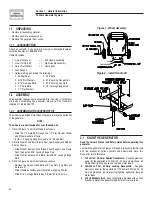
6
6
Section 2 – Operation
Portable Generator System
2.3 CORD SETS AND CONNECTION PLUGS
2.3.1 120 VAC, 20 AMP, DUPLEX RECEPTACLE
This is a 120 Volt outlet protected against overload by a 20 Amp
push-to-reset circuit breaker (Figure 6). Use each socket to power
120 Volt AC, single phase, 60 Hz electrical loads requiring up to a
combined 2400 watts (2.4 kW) or 20 Amps of current. Use only high
quality, well-insulated, 3-wire grounded cord sets rated for 125 Volts
at 20 Amps (or greater).
Keep extension cords as short as possible, preferably less than 15
feet long, to prevent voltage drop and possible overheating of wires.
Figure 6 - 120 Volt AC, 20 Amp, Duplex Receptacle
2.3.2 120/240 VAC, 30 AMP RECEPTACLE
Use a NEMA L14-30 plug with this receptacle (rotate to lock/unlock).
Connect a suitable 4-wire grounded cord set to the plug and to the
desired load. The cord set should be rated for 250 Volts AC at 30
Amps (or greater) (Figure 7).
Figure 7 - 120/240 VAC, 30 Amp Receptacle
Use this receptacle to operate 120 Volt AC, 60 Hz, single phase loads
requiring up to 3600 watts (3.6 kW) of power at 30 Amps or 240 Volt
AC, 60 Hz, single phase loads requiring up to 7200 watts (7.2 kW) of
power at 30 Amps. The outlet is protected by 21/23/27 Amp (2-pole
magnetic) circuit breakers for 5kW/5.5kW/6.5kW.
2.4 HOW TO USE THE GENERATOR
If there are any problems operating the generator, please call the
generator helpline at 1-888-436-3722.
2.4.1 GROUNDING
THE
GENERATOR
The National Electrical Code requires that the frame and external
electrically conductive parts of this generator be properly
connected to an approved earth ground (Figure 8)
. Local electrical
codes may also require proper grounding of the unit. For that purpose,
connecting a No. 10 AWG (American Wire Gauge) stranded copper
wire to the grounding lug and to an earth-driven copper or brass
grounding rod (electrode) provides adequate protection against
electrical shock. However, local codes may vary widely.
Consult with
a local electrician for grounding requirements in the area.
Figure 8 - Grounding the Generator
Proper grounding of the generator will help prevent electrical
shock
in the event of a ground fault condition in the generator or in
connected electrical devices. Proper grounding also helps dissipate
static electricity, which often builds up in ungrounded devices.
2.4.2 CONNECTING ELECTRICAL LOADS
DO NOT
connect 240 Volt loads to 120 Volt receptacles.
DO NOT
connect 3-phase loads to the generator.
DO NOT
connect 50 Hz loads
to the generator.
Let engine stabilize and warm up for a few minutes after starting.
•
Plug in and turn on the desired 120 or 240 Volt AC, single phase,
•
60 Hz electrical loads.
Add up the rated watts (or amps) of all loads to be connected
•
at one time. This total should not be greater than (a) the rated
wattage/amperage capacity of the generator or (b) circuit breaker
rating of the receptacle supplying the power. See "Don't Overload
the Generator".
Содержание 005688-0
Страница 15: ...13 Section 5 Notes ...
Страница 18: ...16 ...
Страница 31: ...29 4 3 Sección 5 Notas ...
Страница 34: ...32 ...
Страница 47: ...45 REMARQUES Section 5 Remarques ...









































